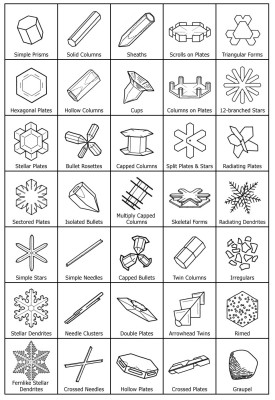 A Guide
to Snowflakes A Guide
to Snowflakes
... A look at the different types of falling snow ...
If you look closely at falling snow, you can see a
great many different crystal shapes. There's a lot more to see
than you might think!
The table at right shows the more common
and/or
distinctive types of snowflakes. Click on the table for a more detailed look,
then scroll down this page for examples of the different types.
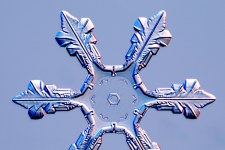 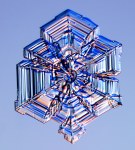
This page is an abbreviated version of
my
Field Guide to Snowflakes. |
| Types
of Snowflakes |
 Simple
Prisms Simple
Prisms
A hexagonal prism is the most basic snow crystal geometry
(see the
Snowflake Primer). Depending on how fast the different facets
grow, snow crystal prisms can appear as thin hexagonal plates, slender
hexagonal columns (shaped a lot like wooden pencils), or anything in
between. Simple prisms are usually so small they can barely be
seen with the naked eye. |
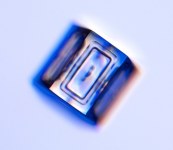 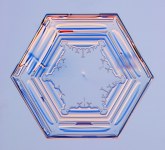 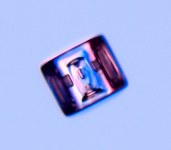 The
examples at right show two stubby prisms and one thin plate. Snow
crystal facets are rarely perfectly flat, being more typically decorated
with various indents, ridges, or other features. The
examples at right show two stubby prisms and one thin plate. Snow
crystal facets are rarely perfectly flat, being more typically decorated
with various indents, ridges, or other features. |
|
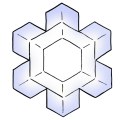 Stellar Plates Stellar Plates
These common snowflakes are thin, plate-like crystals with
six broad arms that form a star-like shape. Their faces are often
decorated with amazingly elaborate and symmetrical markings. |
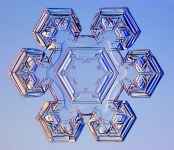 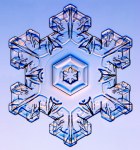 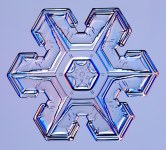 Plate-like
snowflakes form when the temperature is near -2 C (28 F) or near -15 C
(5 F), as dictated by the
snow crystal morphology diagram. Plate-like
snowflakes form when the temperature is near -2 C (28 F) or near -15 C
(5 F), as dictated by the
snow crystal morphology diagram. |
|
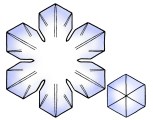 Sectored Plates Sectored Plates
Stellar plates often show distinctive ridges that point to
the corners between adjacent prism facets. When these ridges are
especially prominent, the crystals are called sectored plates. |
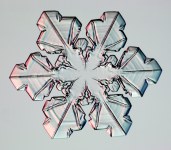 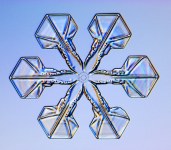 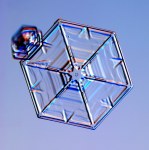 The
simplest sectored plates are hexagonal crystals that are divided into
six equal pieces, like the slices of a hexagonal pie. More complex
specimens show prominent ridges on broad, flat branches. The
simplest sectored plates are hexagonal crystals that are divided into
six equal pieces, like the slices of a hexagonal pie. More complex
specimens show prominent ridges on broad, flat branches. |
|
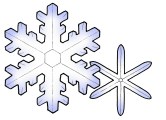 Stellar
Dendrites Stellar
Dendrites
Dendritic means "tree-like", so stellar dendrites are
plate-like snow crystals that have branches and sidebranches.
These are fairly large crystals, typically 2-4 mm in diameter, that are
easily seen with the naked eye. |
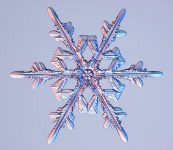 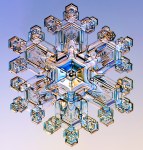 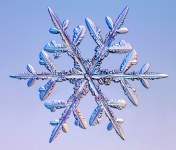 Stellar
dendrites are clearly the most popular snow crystal type, seen in
holiday decorations everywhere. You can see these crystals for
yourself quite well with just a simple magnifier. (See
Snowflake Watching for more about observing snowflakes.) Stellar
dendrites are clearly the most popular snow crystal type, seen in
holiday decorations everywhere. You can see these crystals for
yourself quite well with just a simple magnifier. (See
Snowflake Watching for more about observing snowflakes.) |
|
 Fernlike
Stellar Dendrites Fernlike
Stellar Dendrites
Sometimes the branches of stellar crystals have so many
sidebranches they look a bit like ferns, so we call them fernlike
stellar dendrites. These are the largest snow crystals, often
falling to earth with diameters of 5 mm or more. In spite of their
large size, these are single crystals of ice -- the water molecules are
lined up from one end to the other. |
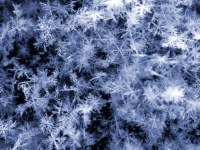 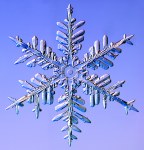 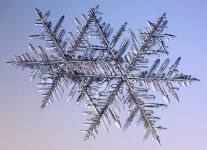 Some
snowfalls contain almost nothing but stellar dendrites and fernlike
stellar dendrites. It can make quite a sight when they collect in
vast numbers, covering everything in sight. Some
snowfalls contain almost nothing but stellar dendrites and fernlike
stellar dendrites. It can make quite a sight when they collect in
vast numbers, covering everything in sight.
The best powder snow, where you sink to your knees while skiing, is made
of stellar dendrites. These crystals can be extremely thin and
light, so they make a low density snowpack. |
|
 Hollow Columns Hollow Columns
Hexagonal columns often form with conical hollow regions in
their ends, and such forms are called hollow columns. These
crystals are small, so you need a good magnifier to see the hollow
regions. |
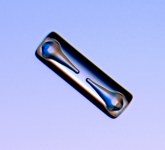 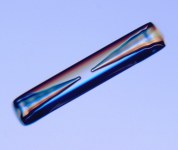 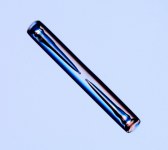 Note
how the two hollow regions are symmetrical in each column.
Sometimes the ends grow over and enclose a pair of bubbles in the ice,
as seen in the last picture on the right. Note
how the two hollow regions are symmetrical in each column.
Sometimes the ends grow over and enclose a pair of bubbles in the ice,
as seen in the last picture on the right. |
|
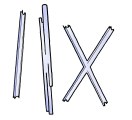 Needles Needles
Needles are slender, columnar ice crystals that grow when
the temperature is around -5 C (23 F). On your sleeve these
snowflakes look like small bits of white hair. |
 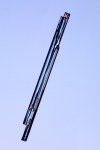 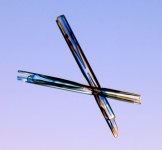 One
of the amazing things about snow crystals is that their growth changes
from thin, flat plates to long, slender needles when the temperature
changes by just a few degrees. Why this happens remains something
of a scientific mystery. One
of the amazing things about snow crystals is that their growth changes
from thin, flat plates to long, slender needles when the temperature
changes by just a few degrees. Why this happens remains something
of a scientific mystery. |
|
 Capped
Columns Capped
Columns
These crystals first grow into stubby columns, and then
they blow into a region of the clouds where the growth becomes
plate-like. The result is two thin, plate-like crystals growing on
the ends of an ice column. Capped columns don't appear in every
snowfall, but you can find them if you look for them. |
 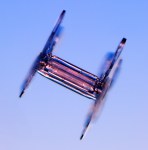 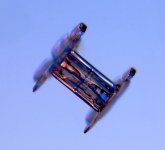  The
first example at right shows three views of a capped column. The
first view is from the side, showing the central column and the two
plates edge-on. The other two views show the same crystal from one
end, with the microscope focused separately on the two plates. The
first example at right shows three views of a capped column. The
first view is from the side, showing the central column and the two
plates edge-on. The other two views show the same crystal from one
end, with the microscope focused separately on the two plates. |
|
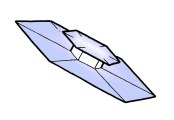 Double Plates Double Plates
A double plate is basically a capped column with an
especially short central column. The plates are so close together
that inevitably one grows out faster and shields the other from its
source of water vapor. The result is one large plate connected to
a much smaller one. These crystals are common -- many snowflakes
that look like ordinary stellar plates are actually double plates if you
look closely. |
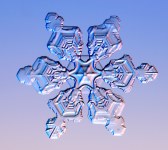 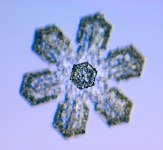 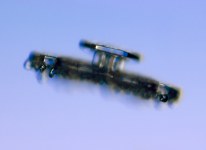 The
first picture at right shows a double plate from the side. The
second picture shows a double plate with the microscope focused on the
smaller plate. In the third picture, note the slightly
out-of-focus hexagon that is about one-sixth as large as the main
crystal. This hexagon is the second side of a double plate,
connected to the main plate by a small axle. The
first picture at right shows a double plate from the side. The
second picture shows a double plate with the microscope focused on the
smaller plate. In the third picture, note the slightly
out-of-focus hexagon that is about one-sixth as large as the main
crystal. This hexagon is the second side of a double plate,
connected to the main plate by a small axle. |
|
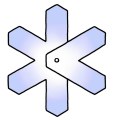  Split Plates
and Stars Split Plates
and Stars
These are forms of double plates, except that part of one
plate grows large along with part of the other plate. The picture
at right shows all eight ways to make a split star. Split plates
and stars, like double plates, are common but often unnoticed. |
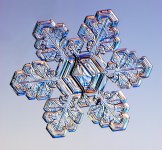 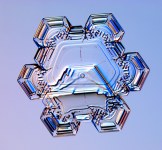 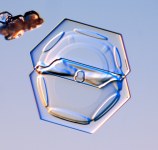 You
may have to stare at these pictures a bit to see how the two distinct
pieces fit together. Note how in each case the crystals are
connected in the center with short axles. You
may have to stare at these pictures a bit to see how the two distinct
pieces fit together. Note how in each case the crystals are
connected in the center with short axles. |
|
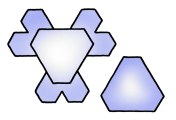 Triangular
Crystals Triangular
Crystals
Plates sometimes grow as truncated triangles when the
temperature is near -2 C (28 F). If the corners of the plates
sprout arms, the result is an odd version of a stellar plate crystal.
These crystals are relatively rare. |
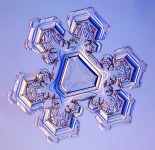 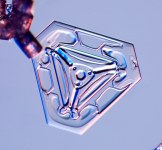  Surprisingly,
no one knows why snow crystals grow into these three-fold symmetrical
shapes. (Note however that the molecular structure of triangular
crystals is no different from ordinary six-sided crystals. The
facet angles are all the same.) Surprisingly,
no one knows why snow crystals grow into these three-fold symmetrical
shapes. (Note however that the molecular structure of triangular
crystals is no different from ordinary six-sided crystals. The
facet angles are all the same.) |
|
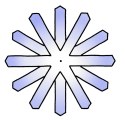 12-Sided
Snowflakes 12-Sided
Snowflakes
Sometimes capped columns form with a twist, a 30-degree
twist to be specific. The two end-plates are both six-branched
crystals, but one is rotated 30 degrees relative to the other.
This is a form of crystal twinning, in which two crystals grow
joined in a specific orientation. |
 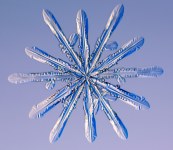 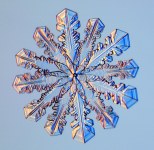 These
crystals are quite rare, but sometimes a snowfall will bring quite a
few. The picture at the far right shows a 12-sider where the two
halves are widely separated. These
crystals are quite rare, but sometimes a snowfall will bring quite a
few. The picture at the far right shows a 12-sider where the two
halves are widely separated. |
|
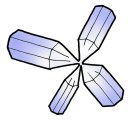 Bullet
Rosettes Bullet
Rosettes
The nucleation of an ice grain sometimes yields multiple
crystals all growing together at random orientations. When the
different pieces grow into columns, the result is called a bullet
rosette. These polycrystals often break up to leave isolated
bullet-shaped crystals. |
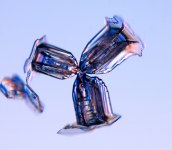 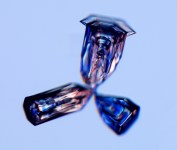 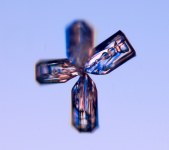 Sometimes
a bullet rosette can become a capped rosette, as shown in the example at
the far right. Sometimes
a bullet rosette can become a capped rosette, as shown in the example at
the far right. |
|
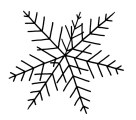 Radiating
Dendrites Radiating
Dendrites
When the pieces of a polycrystal grow out into dendrites,
the result is called a radiating dendrite (also called a spatial
dendrite). |
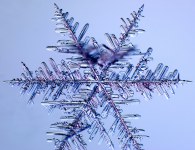 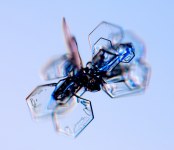 The
first example on the right shows radiating plates. The second
example shows a fernlike stellar dendrite with two errant branches
growing up out of the main plane of the crystal. The
first example on the right shows radiating plates. The second
example shows a fernlike stellar dendrite with two errant branches
growing up out of the main plane of the crystal. |
|
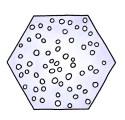 Rimed
Crystals Rimed
Crystals
Clouds are made of countless water droplets, and sometimes
these droplets collide with and stick to snow crystals. The frozen
droplets are called rime. All the different types of snow crystals
can be found decorated with rime. When the coverage is especially
heavy, so that the assembly looks like a tiny snowball, the result is
called graupel. |
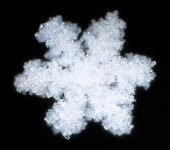 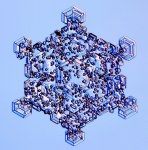 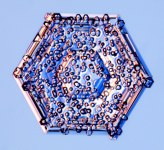 The
first two pictures at right have relatively light rime coverage.
The final example is completely covered with rime, but you can still see
the six-fold symmetry of the underlying stellar crystal. The
first two pictures at right have relatively light rime coverage.
The final example is completely covered with rime, but you can still see
the six-fold symmetry of the underlying stellar crystal. |
|
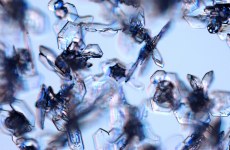 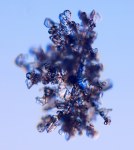 Irregular Crystals Irregular Crystals
The most common snow crystals by far are the irregular
crystals. These are small, usually clumped together, and show
little of the symmetry seen in stellar or columnar crystals. |
|
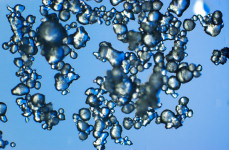  Artificial
Snow Artificial
Snow
Snow machines shoot a mixture of water and compressed air
out of nozzles. The water comes out as fine droplets, and the air
cools as it decompresses, causing the droplets to freeze. A fan
blows the ice particles onto the slopes. You can see from the picture at right that
artificial snow is made of frozen water droplets, with none of the
elaborate structure found in real snow crystals. |
|
If you want to go outside and look
at snow crystals for yourself, I recommend my new
book --
Ken Libbrecht's Field Guide to Snowflakes. This book contains a much more complete list of
the different snow crystal types, along with how to find them.
Once you know what to look for, snowflake watching is a fascinating
recreation!
|
|
Classifying
Snowflakes |
How does one classify
snowflakes? It's not so easy, because how you divide the different types is somewhat a
matter of taste. There is a good analogy with breeds of dogs.
The definition of different breeds is decided upon by a committee of
people, and really one can make up as many breeds as one wants.
And no matter how many different breeds you define, some dogs will be
mixed, not belonging to any one breed.
Snowflakes do come in different types, and you need to give them
names if you want to talk about them. But there will never be a
precise way to define the different types. I prefer the 35 types
shown at the top of this page, but others have come up with alternate
classifications schemes. Some of these are shown below.
|
 International Classification
System International Classification
System
In 1951 the International Commission on
Snow and Ice produced a fairly simple and widely used classification
system for solid precipitation [1]. This system defines the
seven principal snow crystal types as plates, stellar crystals, columns,
needles, spatial dendrites, capped columns, and irregular forms.
To these are added three additional types of frozen precipitation:
graupel, ice pellets, and hail. This is a fine classification
system, but in my opinion it's too simplistic to be very interesting.
|
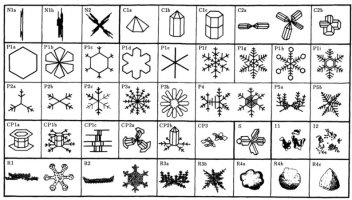 Nakaya's
Classification Nakaya's
Classification
Physicist Ukichiro Nakaya (see Historic
Snowflakes) created the first systematic classification scheme for
snowflakes, in which he subdivided falling snow into 41 individual
morphological types [2]. |
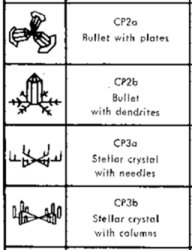 Magono and Lee Magono and Lee
The most complex classification scheme is an extension of
Nakaya's table, published by meteorologists C. Magono and C. W. Lee in 1966 [3].
This table includes 80 different snow crystal types. |
|
[1] B. Mason, in The Physics of
Clouds (Oxford University Press, 1971)
[2] U. Nakaya, Snow Crystals: Natural and Artificial (Harvard University
Press, 1954).
[3] C. Magono and C. W. Lee, Meteorological Classification of Natural Snow
Crystals, Journal of the Faculty of Science, Hokkaido University, 1966. |
